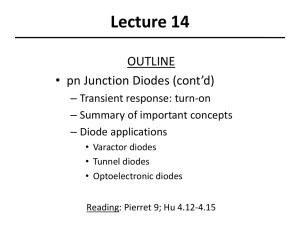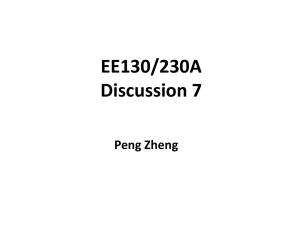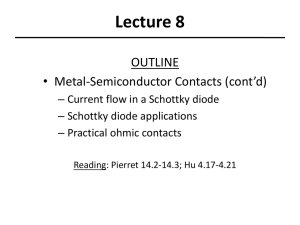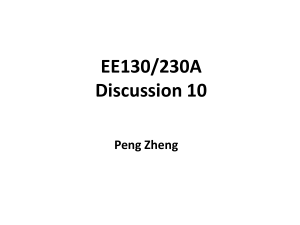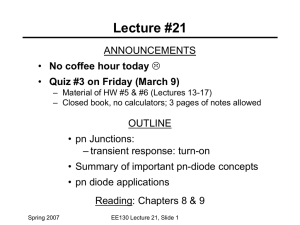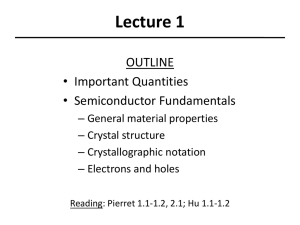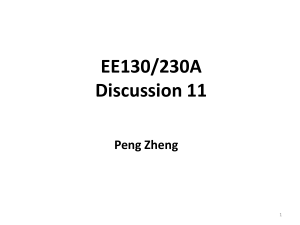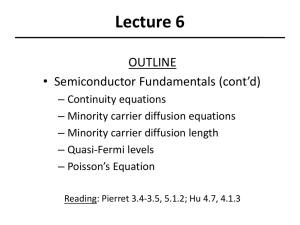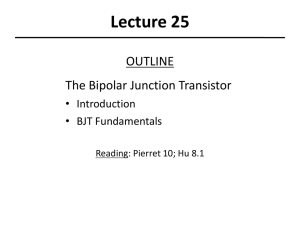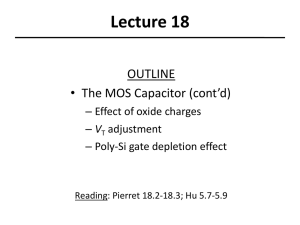Lecture 14 OUTLINE • pn Junction Diodes (cont’d) – Transient response: turn-on
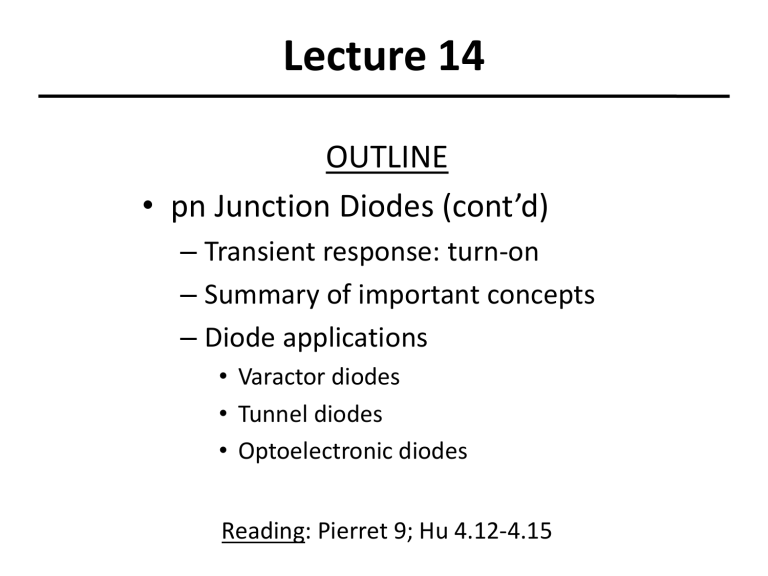
Lecture 14
OUTLINE
• pn Junction Diodes (cont’d)
– Transient response: turn-on
– Summary of important concepts
– Diode applications
• Varactor diodes
• Tunnel diodes
• Optoelectronic diodes
Reading: Pierret 9; Hu 4.12-4.15
Turn-On Transient
Consider a p + n diode (Q p
D p n
(x)
>> Q n
):
i(t) x x n
For t > 0: dp n dx x
x n
i qAD p
0
EE130/230A Fall 2013 Lecture 14, Slide 2 v
A
(t) t t
dQ p dt
i
Q p
τ p
I
F
Q p for t
τ p
0
• By separation of variables and integration, we have
Q p
( t )
I
F
τ p
1
e
t /
τ p
• If we assume that the build-up of stored charge occurs quasi-statically so that
Q p
( t )
I diffusion
τ p
I
0
e qv
A
/ kT
1
τ p then v
A
(
t
)
kT
ln
1
q
I
F
I
0
1
e
t / τ p
EE130/230A Fall 2013 Lecture 14, Slide 3
• If t p is large, then the time required to turn on the diode is approximately
D
Q/I
F
where
D
Q
D
Q p
D
Q j
EE130/230A Fall 2013 Lecture 14, Slide 4
Summary of Important Concepts
• Under forward bias, minority carriers are injected into the quasi-neutral regions of the diode.
• The current flowing across the junction is comprised of hole and electron components.
– If the junction is asymmetrically doped (i.e. it is “one-sided”) then one of these components will be dominant.
• In a long-base diode, the injected minority carriers recombine with majority carriers within the quasineutral regions.
EE130/230A Fall 2013 Lecture 14, Slide 5
• The ideal diode equation stipulates the relationship between J
N
(-x p
) and J
P
(x n
):
J
N
(
x p
)
J
P
( x n
)
D n
L p
N
D
D p
L n
N
A
n i
2 p
side n i
2 n
side
For example, if holes are forced to flow across a forward-biased junction, then electrons must also be injected across the junction.
EE130/230A Fall 2013 Lecture 14, Slide 6
• Under reverse bias, minority carriers are collected into the quasi-neutral regions of the diode.
– Minority carriers generated within a diffusion length of the depletion region diffuse into the depletion region and then are swept across the junction by the electric field.
The negative current flowing in a reverse-biased diode depends on the rate at which minority carriers are supplied from the quasi-neutral regions.
• Electron-hole pair generation within the depletion region also contributes negative diode current.
EE130/230A Fall 2013 Lecture 14, Slide 7
pn Junction as a Temperature Sensor
EE130/230A Fall 2013
C. C. Hu, Modern Semiconductor Devices for ICs, Figure 4-21
Lecture 14, Slide 8
Varactor Diode
• Voltage-controlled capacitance
– Used in oscillators and detectors
(e.g. FM demodulation circuits in your radios)
– Response changes by tailoring doping profile:
C j
V r
n
V for r
V bi n
m
1
2
EE130/230A Fall 2013 Lecture 14, Slide 9
Optoelectronic Diodes
I
I
L
I
0 q V
( e A kT
qA ( L
P
1
W
)
I
L
L
N
) G
L
EE130/230A Fall 2013 Lecture 14, Slide 10 R.F. Pierret, Semiconductor Fundamentals, Figure 9.2
Open Circuit Voltage, V
OC
V oc
V
A
I
0
kT q ln
L p t p
L p
W
L n
p n
L n t n n p
G
L
1
EE130/230A Fall 2013 Lecture 14, Slide 11 C. C. Hu, Modern Semiconductor Devices for ICs, Figure 4-25(b)
Solar Cell Structure
Cyferz at en.wikipedia
EE130/230A Fall 2013 Lecture 14, Slide 12
Textured Si surface for reduced reflectance
• Achieved by anisotropic wet etching (e.g. in KOH)
P. Papet et al ., Solar Energy Materials and Solar Cells, Vol. 90, p. 2319, 2006
EE130/230A Fall 2013
Lecture 14, Slide 13
M. A. Green et al., IEEE Trans. Electron Devices, Vol. 37, pp. 331-336, 1990
p-i-n Photodiodes
• W
W i-region
, so most carriers are generated in the depletion region
faster response time (~10 GHz operation)
• Operate near avalanche to amplify signal
EE130/230A Fall 2013 Lecture 14, Slide 14
R.F. Pierret, Semiconductor Fundamentals, Figure 9.5
Light Emitting Diodes (LEDs)
• LEDs are made with compound semiconductors (direct bandgap)
R.F. Pierret, Semiconductor Fundamentals, Figure 9.13
R.F. Pierret, Semiconductor Fundamentals, Figure 9.15
EE130/230A Fall 2013 Lecture 14, Slide 15
Question 1 (re: Slide 12): Why are the contacts to the back
(non-illuminated) side of a solar cell made only at certain points (rather than across the entire back surface)?
Answer: To increase energy conversion efficiency i) The absorption depth (average distance a photon travels before transferring its energy to an electron) for longwavelength photons is greater than the Si thickness.
The bottom surface oxide and metal layer effectively form a mirror that reflects light back into the silicon.
ii)There is more recombination in heavily doped contacts than at a good Si/SiO
2 interface; most of the back surface should be covered by SiO
2 so that generated carriers have a high probability of diffusing to the depletion region before they recombine.
EE130/230A Fall 2013 Lecture 14, Slide 16
Question 2 (re: Slide 15): What limits the lifetime of an LED?
Answer: i) LED lifetime is defined to be the duration of operation after which the light output falls to only 70% of original.
(Even afterwards, the LED will continue to function.) ii) The power density of an LED can be high (up to 10 W/cm 2 , comparable to an electric stove top), causing significant heating which can degrade the light output through various mechanisms:
1.Degradation of epoxy package causing partial absorption of light
2.Mechanical stress weakening the wire bond (electrical connection)
3.Formation/growth of crystalline defects, or diffusion of metal into the semiconductor, resulting in increased recombination via midgap states
EE130/230A Fall 2013 Lecture 14, Slide 17
